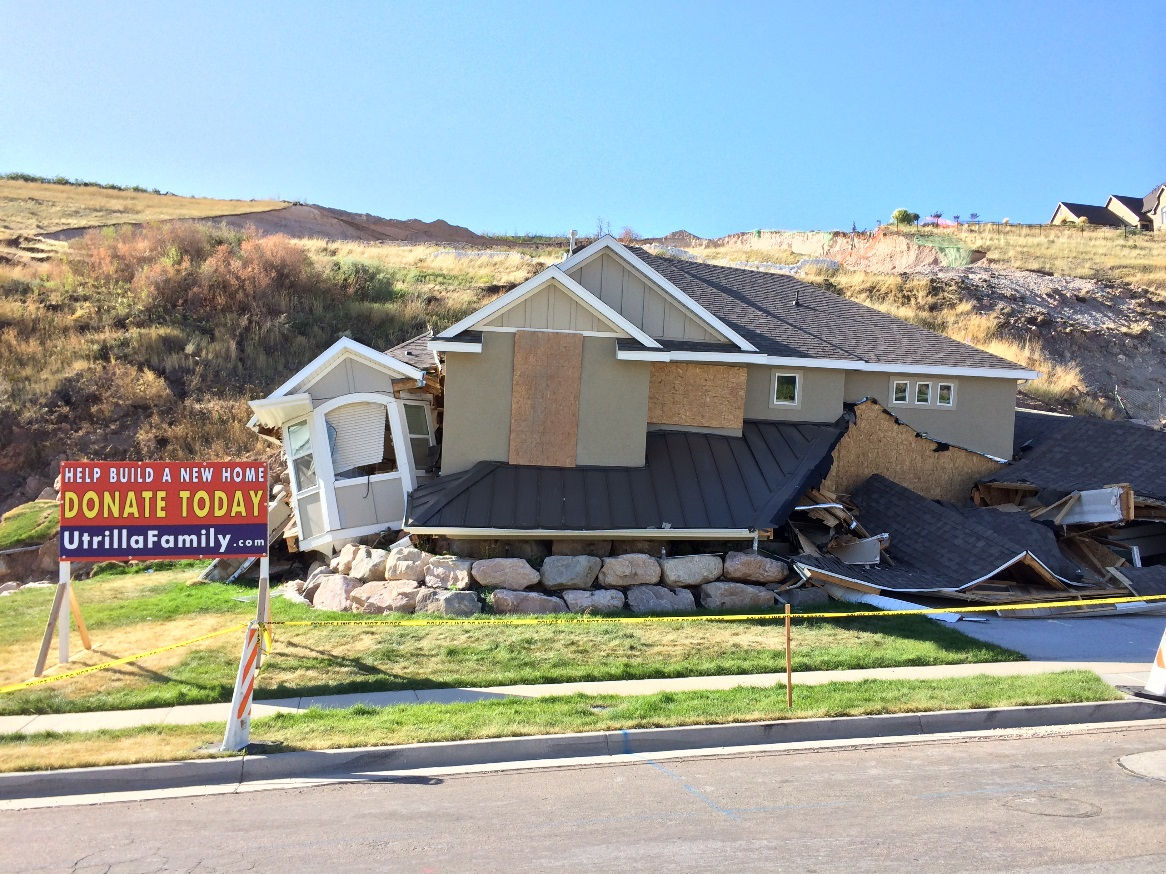Fiscal Highlights 2014
|
Where Is the Geologic Hazards Information? -
Ivan D. Djambov ( The landslide of August 5, 2014 in North Salt Lake left one home destroyed and neighbors worried about their own homes, with one of them quoted in the media wondering "Did we build in the right place?" How can home buyers and local government officials know if an area is safe in terms of geologic hazards?
The home construction process includes permitting and inspections, but generally, the home owners are not provided with information on geological hazards in the area. And also, damages or destruction to their property due to geologic hazards are not covered in the regular homeowners insurance. Many local government officials are also left in "the dark" as they respond to requests for rezoning to accommodate proposed new development in their boundaries without the needed geological hazard data. The lack of this information often leads local governments to permit areas that are not suitable for development. The results include excessive maintenance costs and potential liability from damaged streets, sidewalks, and utility infrastructure (water, sewer, and stormwater), along with increased expenses for private electric, gas, and communications utilities. These costs are ultimately borne by the taxpayer and utility subscribers. An example of this is SunCrest development in the Draper area. Is there any geologic hazards information available for Utah? The answer is yes, for some areas. The Geologic Hazards Program (http://geology.utah.gov/ghp/), which is part of the Utah Geological Survey (UGS), provides geologic hazard map sets for urban and rapidly-developing areas (see page 1 of http://geology.utah.gov/surveynotes/archives/snt41-3.pdf). UGS staff prepares 10 or more maps for each area, including the following types of hazards:
Analysis to develop the maps uses a variety of information, such as:
For more information on geologic hazards in Utah, please visit http://geology.utah.gov/ghp/consultants/index.htm. The Geologic Hazards Program has had two engineering geologists positions since 2009, tasked with the developing of these comprehensive geologic hazard map sets. Due to the time and data intensive, and highly technical nature of preparing these maps, publication is somewhat slow. So far, the program has completed two sets for part of western Salt Lake Valley (see the Magna and Copperton quadrangles at http://geology.utah.gov/online/ss/ss-137/ss-137.pdf and http://geology.utah.gov/online/ss/ss-152.pdf) with ongoing mapping in southern Salt Lake Valley and Utah Valley. Mapping priorities are based on growth and development projections. In the next five years, UGS plans to map the following areas:
Geologic hazard maps and other related information are not intended to prevent development. The purpose is to facilitate sustainable development, and to limit future disasters with life, safety, and economic damages to landowners and local governments. This kind of information is intended to help home buyers and others make educated decisions before they make their investments. The key is to provide geologic hazard information for all areas in Utah, to make it easy to understand and use, and to put it in the hands of the public as soon as possible. |
Coyote Removal Program - Ivan D. Djambov The Division of Wildlife Resources (DWR) has been working to improve the mule deer numbers in Utah ...DAS and DTS Reports - Gary K. Ricks In the last few months, the Departments Technology Services and Administrative Services and ha...How Close Did We Come to the Cap on Sales Tax Earmarks for Transportation in FY 2014? - Steven M. Allred Since 2005, the Legislature has earmarked portions of the sales tax for highway construction projec...How Have Tax Changes in Utah Compared to the Nation? - Thomas E. Young Every spring and winter, the National Association of State Budget Officers (NASBO) releases numbers...Income Tax Appropriations to Public and Higher Education - Ben Leishman In November 1996, Utah voters amended the Utah Constitution to formally authorize the pra...Pew Final Key Findings - Gary R. Syphus After several months of research, the Pew Charitable Trusts' Public Safety Performance Project ...Snow College Concurrent Enrollment Update - Spencer C. Pratt During the 2014 General Session, the Legislature passed S.B. 38, "Snow College C...The Changing Demographics of Expected Income - Angela J. Oh The two recent recessions and subsequent recoveries continue to affect expected lifetime income by ...Utah's Credit Rating and Debt Measures - Brian Wikle Did you know the State of Utah has a credit score? Although the stat...Utah's Revenue Continues to Grow - Andrea Wilko Utah ended FY 2014 with a $166 million General and Education Fund revenue surplus. The revenu... |
Reports/Archive | Budget Process | Office Background | Who's Who | Organization Chart
Office of the Legislative
Fiscal Analyst
House Building, Suite W310
Salt Lake City, UT 84114
Phone (801) 538-1034 Fax (801) 538-1692
